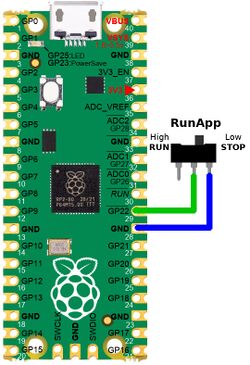Différences entre versions de « ENG-CANSAT-PICO-MISSION1-AUTONOMOUS »
Sauter à la navigation
Sauter à la recherche
| Ligne 17 : | Ligne 17 : | ||
This approach is very efficient but can lead to plateform lock-up when the script is buggy or contains an infinite loop. | This approach is very efficient but can lead to plateform lock-up when the script is buggy or contains an infinite loop. | ||
| − | {{ambox|text=At MCHobby we do use a slide switch name "RunApp" as recovery method. | + | {{ambox|text=At MCHobby we do use a slide switch name "RunApp" as recovery method.}} |
The aim is to check the status of a given pin (eg: GP22) before starting the user script (say {{fname|user.py}}). | The aim is to check the status of a given pin (eg: GP22) before starting the user script (say {{fname|user.py}}). | ||
Version du 21 mars 2022 à 00:34
Inroduction
Until now, we have worked with the emitter linked to a computer via USB cable.
Using the USB cable was very useful to capture the debugging message into the REPL Session.
We have two things to do:
- Start automatically your python script
- Making the CANSAT working autonomously
Start your Python script
If you want your script to start when powering up your Pico, just copy the script content into a file named main.py .
This approach is very efficient but can lead to plateform lock-up when the script is buggy or contains an infinite loop.
| At MCHobby we do use a slide switch name "RunApp" as recovery method. |
The aim is to check the status of a given pin (eg: GP22) before starting the user script (say user.py).
In case of trouble during testing/development we just switch-off the "RunApp" and press the reset button to restart the Pico.
Here is the content of main.py script.
from machine import Pin
run = Pin( 22, Pin.IN, Pin.PULL_UP )
if run.value() == 1:
import user # load user.py file and execute it
Written by Meurisse D. for MCHobby

